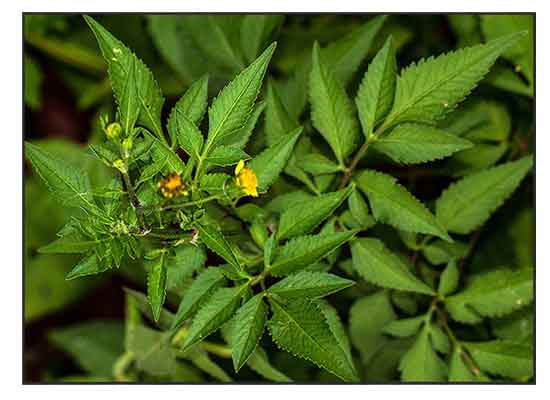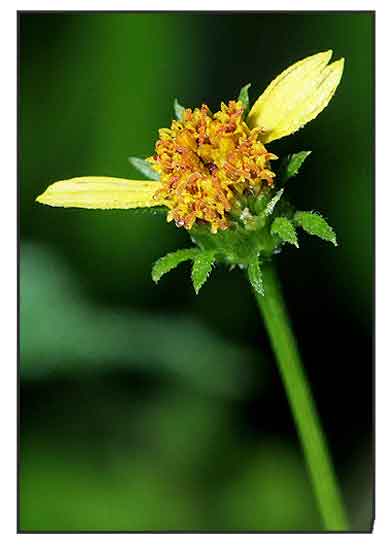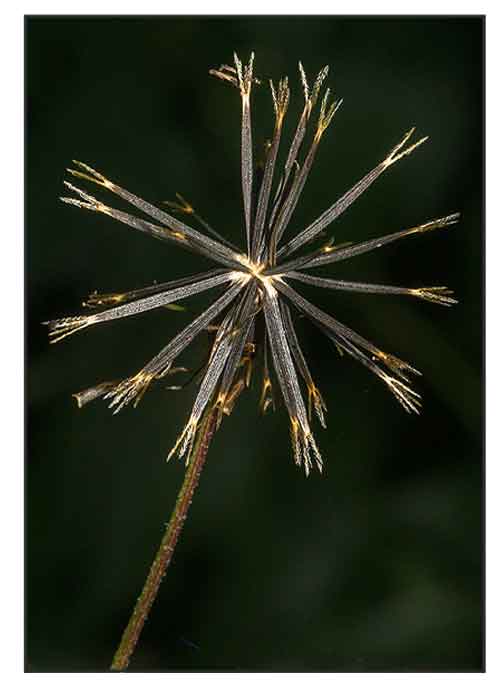Gen info
- Bidens is a genus of flowering plants in the aster family, Asteraceae. The genus includes about 230 species. Although worldwide in distribution, the genus systematics and taxonomy is described as complicated and unorganized.
- Etymology: The genus name Bidens derives from Latin words bi (two) and dens (tooth), referring to the two bristles on the achenes (seed-like fruits) of many species in the genus. The specific epithet biternata refers to the plant leaves, which are ternately compound of three leaflets at the basal level, sometimes further dividing, forming a "twice-ternate" appearance.
 Botany Botany
• An annual, erect herb up to 1.5(-2) m tall, stem 4-angular, glabrous to pubescent. Leaves opposite or rarely alternate towards the apex, pinnately (3-)5-9-lobed, 9-19 cm long, glabrous to densely tomentose, the segments ovate to ovate-lanceolate, the lower ones often pinnatifid, crenate-serrate or rarely lobulate-dentate, petiolate. Capitula in lax paniculate cymes, usually radiate, 5-7 mm broad, outer involucral bracts (4-)5-10(-15), (3-)4-7(-12) mm × 0.4-0.7 mm, much narrower than the inner ones. Ray flowers (0-)2-5, sterile, corolla 3-6 mm long, yellow, disk flowers with yellow, 3-5.5 mm long corolla. Achene linear, 4-8-ribbed, 6-16(-20) mm long, with (2-)3-4(-5) retrorsely barbed bristles of (1-)2-4 mm long. (1)
• Yellow Flowered Blackjack is an erect annual herb, up to 1 m. Closely related to B. pilosa, but can be distinguished by the leaves, which are usually 5-7 foliolate, with the lowermost pair redivided into two to three segments. The outer involucral bracts resemble those of B. bipinnata. The achenes are up to 16 mm long, almost glabrous. The flowers are yellow, including the ray-florets. Yellow Flowered Blackjack is a widespread weed of disturbed and cultivated areas. It is also found in the Himalayas, up to an altitude of 1100-2000 m. (Flowers of India)
Distribution
- Native to the
Philippines.
- Also native to Afghanistan, Angola, Assam, Benin, Botswana, Burkina, Cambodia, Cameroon, Cape Provinces, Central African Republic, Chad, China North-Central, China South-Central, China Southeast, Djibouti, DR Congo, Eritrea, Ethiopia, Free State, Ghana, Guinea, Hainan, India, Ivory Coast, Japan, Jawa, Kenya, Korea, KwaZulu-Natal, Laccadive Is., Lesotho, Manchuria, Mozambique, Myanmar, Namibia, Nansei-shoto, Nepal, New Guinea, Northern Provinces, Northern Territory, Oman, Pakistan, Queensland, Saudi Arabia, Socotra, Sri Lanka, Sudan-South Sudan, Taiwan, Tanzania, Thailand,
Tonga, Uganda, Vietnam, West Himalaya, Western Australia, Yemen, Zambia, Zimbabwe. (2)
- A widespread, pestiferous crop weed and wasteland plant.
 Constituents Constituents
- Study of ethanol extract of B. biternata identified Tris (2,4-di-tert-butylphenyl), 4-hydroxy-2,4′-dimethoxychalcone, and 2,4-di-tert-butylphenol.
(see study below) (4)
- Study of crude methanol extract isolated compound quercetin (3, 3’, 4’, 5, 7- pentahydroxy flavones) of B. biternata
. (see study below) (6)
- Study of ground plant sample revealed phenolics 4 mg/gm, alkaloids 34 mg/gm, and flavonoids 152 mg/gm. Elemental analysis revealed Ca 24,563.60 ppm, Fe 710.778 ppm, K 23,017.80 ppm,
Mg 8615.23 ppm,
Na 88.70. (see study below)Â Â (7)
- Nutritional analysis of methanol and chloroform extracts of powdered whole plant revealed presence of anthraquinone, terpenoids saponins, alkaloids, glycosides, steroids and tannins. (see study below) (8)
- Phytochemical screening of methanol extract of mature leaves, young leaves, stem and root showed presence of glycosides, flavonoids, alkaloids, steroids and tannins with absence of anthraquinones, phlobatannins, iridoids. (9)
Properties
- Studies have suggested anticancer, antidiarrheal, nutraceutical, hypolipidemic, antimicrobial, antioxidant, anti-steatotic, anti-inflammatory properties.
 Parts used Parts used
Leaves.
Uses
Edibility
- Limited edibility use and commercial availability. Used as a wild leafy vegetable in the village communities of Western Ghats.
(Study below supports its edible use and future potential in nutrition.) (7)
Folkloric
- No reported folkloric medicinal use in the Philippines.
- In traditional medicines, used against inflammation, infections, diabetes, malaria, leprosy, ulcers, diarrhea and digestive disorders.
- In Chinese traditional medicine used for treatment of appendicitis, sore throat, diarrhea, dysentery, and stomach ache. (13)
- Leaf juice used for treatment of eye and ear infections. Rubbed leaves are applied to skin infections; as a hemostatic on wounds; wrapped around umbilical cord of babies. (1)
- In Kerala, India, used for treatment of hepatitis, inflammation, cold, cough, dysentery, asthma.
Others
- Veterinary: Seeds as used as anthelmintic (1)
Studies
• Anticancer: Study evaluated the anticancer potential of three ethno-medicinally important plant species i.e., Bidens biternata, B. bipinnata, and B. pilosa. In vitro evaluation using MTT assay was performed against cervical cancer cells (HeLa), hepatocellular carcinoma (HepG), and adenocarcinoma human alveolar basal epithelial cells (A549). For invivo evaluation, Artemia salina, Danio rerio, and Caenorhabditis elegans were used. The ethanol extract of B. biternata showed highest anticancer activity, which was attributed to compounds identified as Tris (2,4-di-tert-butylphenyl), 4-hydroxy-2,4′-dimethoxychalcone, and 2,4-di-tert-butylphenol. Of these, 4-hydroxy-2,4′-dimethoxychalcone showed highest anticancer activity with LD50 of 236.7 µg/mL, suggesting potential fir chemoprevention and chemotherapy. (4)
• Antidiarrheal: Study evaluated the in vivo and in vitro antidiarrheal activity of freeze dried Biden biternata on Spraque-Dawley rats. The extract showed significant antidiarrheal effects in the castor oil induced diarrhea model (p<0.01) with highest activity at 400 mg/kg dose. Extract showed significant effects on intestinal motility in the charcoal meal test. It showed significant effect on PGE2 induced enteropooling and significant negative effect on contractility of isolated rabbit jejunum. Effects were significantly attenuated by tamsulosin and naloxone. Results showed the freeze-dried extract showed significant antidiarrheal activity in both in vitro and in vivo models, which is probably mediated by modulation of intestinal motility as well as secretory activity. (5)
• Anticancer / Quercetin: Study evaluated crude methanol extract and isolated bioactive compounds of leaves for in vitro anticancer activity against cell lines L929, H9C2, and A375. MTT assay of crude methanol extract showed % viability of normal cell line L929 at 64.2, 53.2, and 49.1 at concentration of 100, 500, and 1000 µg/ml respectively. In quercetin, % cell viability were 51.04%, 47.28%, and 36.27%. The % viability of H9C2 was 90.86, 64.39, and 40.26%; and for isolated compounds quercetin, 86.17, 58.42, and 28.15% at same sample concentrations. In MTT assay of crude ME, % viability of A375 cell line were 94.17, 70.14, and 44.58%, compared to quercetin at 92.14, 68.34, and 38.26%. Results suggest the isolated compound quercetin (3, 3’, 4’, 5, 7- pentahydroxy flavones) of B. biternata has high anticancer activity and has potential as therapeutic agent against cancer disorders. (6)
• Potential as Future and Alternative Food Crop: The plant is not commercially available as foodstuff, but is used as wild leafy vegetable in the village communities of Western Ghats. All parts are used as ingredients in folk medicines. Study revealed remarkable percentage of alkaloids, flavonoids and phenolics, with high concentration of calcium, magnesium, and iron in the leaf extract. Study supports its edible use and potential in nutrition. (see constituents above) (7) Nutritional analysis of methanol and chloroform extracts of powdered whole plant revealed presence of anthraquinone, terpenoids saponins, alkaloids, glycosides, steroids and tannins. High nutritional value was suggested by proteins, total reducing sugar, carbohydrates, amino acids and crude fiber, comparable to many leafy vegetables. Study suggest potential as alternative during food scarcity. (8)
• Antimicrobial Activity / Antioxidant: Phytochemical screening of methanol extract of mature leaves, young leaves, stem and root showed presence of glycosides, flavonoids, alkaloids, steroids and tannins with absence of anthraquinones, phlobatannins, iridoids. Methanol extract showed mild action against S. aureus, E. coli, P. aeruginosa, and K. pneumonia. Methanol extract of leaves was active against fungi such as Aspergillus niger, Alternaria solani, Mucor ramosissimus and Rhizopus nigricans. (9) Study evaluated the methanol and chloroform extracts of whole plant for antibacterial activity by agar well and paper disc diffusion method, antifungal activities through agar tube dilution method, and antioxidant activity by DPPH, reducing power and phosphomolybdenum assays. Both plant extracts showed substantial antimicrobial and antioxidant activities. (11)
• Hypolipidemic / Anti-Steatotic Effects Activity: Study evaluated the anti-steatotic effects of Bidens biternata (JZYP: Jo zhan yin pan) on T2DM-associated hepatic lipid accumulation and its regulatory mechanisms targeting mitochondrial autophagy and lipogenic pathways. JZYP effectively ameliorated hepatic lipid accumulation in T2DM mice via enhancement of mitophagy and suppression of de novo lipogenesis. Findings suggest potential for JZYP as botanical candidate for management of metabolic syndrome-related hepatopathies. (10)
• Anti-Inflammatory / Leaves: Study evaluated a crude methanolic extract of leaves and isolated compound quercetin for in vitro anti-inflammatory activity by cyclooxygenase (COX-2) and 5-lipoxygenase (5-LOX) inhibitory assays. COX-2 inhibitory assay showed % inhibition of 36.71%, 63.92%, and 87.35% at concentrations of 100, 500, and 1000 µg/ml respectively. The 5-LOX inhibitory assay showed % inhibition of 35.64, 61.76, and 85.95%. Quercetin showed higher inhibitory effects in both COX and LOX than the crude extract. Results suggest quercetin (3, 3’, 4’, 5, 7-pentahydroxy flavones) of B. biternata possessed high anti-inflammatory activity and has potential as an effective therapeutic agent against inflammatory disorders. (12)
Availability
- Wild-crafted.
|

![]()






